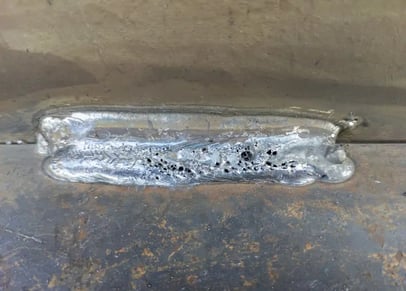What is Porosity in Welding: Best Practices for Staying Clear Of Porous Welds
What is Porosity in Welding: Best Practices for Staying Clear Of Porous Welds
Blog Article
The Science Behind Porosity: A Comprehensive Guide for Welders and Fabricators
Recognizing the detailed devices behind porosity in welding is essential for welders and fabricators pursuing impeccable craftsmanship. As metalworkers explore the depths of this phenomenon, they discover a globe governed by different elements that affect the development of these small voids within welds. From the structure of the base materials to the ins and outs of the welding procedure itself, a plethora of variables conspire to either worsen or alleviate the visibility of porosity. In this thorough guide, we will unravel the scientific research behind porosity, exploring its results on weld quality and introduction advanced strategies for its control. Join us on this journey via the microcosm of welding blemishes, where accuracy fulfills understanding in the search of perfect welds.
Recognizing Porosity in Welding
FIRST SENTENCE:
Examination of porosity in welding reveals essential understandings right into the honesty and quality of the weld joint. Porosity, characterized by the existence of cavities or voids within the weld steel, is a typical worry in welding processes. These gaps, if not properly addressed, can compromise the structural stability and mechanical buildings of the weld, leading to prospective failings in the completed item.

To discover and evaluate porosity, non-destructive screening approaches such as ultrasonic screening or X-ray assessment are usually utilized. These techniques enable the recognition of inner issues without jeopardizing the honesty of the weld. By evaluating the dimension, shape, and circulation of porosity within a weld, welders can make informed decisions to enhance their welding processes and attain sounder weld joints.

Factors Affecting Porosity Development
The incident of porosity in welding is influenced by a myriad of factors, ranging from gas securing effectiveness to the intricacies of welding parameter settings. One important element adding to porosity formation is insufficient gas protecting. When the protecting gas, commonly argon or CO2, is not properly covering the weld pool, climatic gases like oxygen and nitrogen can contaminate the molten metal, leading to porosity. In addition, the cleanliness of the base materials plays a substantial function. Impurities such as corrosion, oil, or moisture can vaporize during welding, developing gas pockets within the weld. Welding specifications, including voltage, present, take a trip rate, and electrode kind, additionally influence porosity development. Making use of improper settings can generate too much spatter find out this here or heat input, which in turn can lead to porosity. The welding method utilized, such as gas steel arc welding (GMAW) or secured metal arc welding (SMAW), can affect important source porosity development due to variants in warmth circulation and gas coverage. Recognizing and regulating these elements are crucial for reducing porosity in welding operations.
Impacts of Porosity on Weld High Quality
Porosity development substantially jeopardizes the structural honesty and mechanical residential or commercial properties of bonded joints. When porosity is existing in a weld, it develops voids or tooth cavities within the product, minimizing the general stamina of the joint. These gaps function as stress concentration points, making the weld extra prone to breaking and failure under load. The existence of porosity additionally deteriorates the weld's resistance to corrosion, as the entraped air or gases within the spaces can respond with the surrounding environment, bring about deterioration in time. In addition, porosity can impede the weld's ability to withstand pressure or effect, more threatening the general quality and integrity of the bonded framework. In vital applications such as aerospace, automobile, or structural constructions, where security and longevity are vital, the harmful effects of porosity on weld high quality can have serious effects, emphasizing the significance of reducing porosity through proper welding strategies and treatments.
Techniques to Reduce Porosity
In addition, making use of the ideal welding specifications, such as the right voltage, existing, and take a trip speed, is crucial in stopping porosity. Maintaining a constant arc length and angle during welding likewise aids decrease the likelihood of porosity.

In addition, selecting the right shielding gas and keeping click proper gas flow rates are necessary in reducing porosity. Using the appropriate welding strategy, such as back-stepping or utilizing a weaving movement, can additionally assist disperse warmth evenly and reduce the possibilities of porosity formation. Guaranteeing correct air flow in the welding environment to eliminate any potential sources of contamination is crucial for attaining porosity-free welds. By implementing these methods, welders can properly lessen porosity and generate premium bonded joints.

Advanced Solutions for Porosity Control
Implementing cutting-edge technologies and innovative techniques plays an essential duty in attaining premium control over porosity in welding processes. Additionally, utilizing advanced welding techniques such as pulsed MIG welding or changed atmosphere welding can additionally help reduce porosity problems.
Another advanced remedy involves using innovative welding tools. Utilizing equipment with integrated functions like waveform control and sophisticated power sources can boost weld top quality and minimize porosity threats. The application of automated welding systems with exact control over specifications can significantly lessen porosity flaws.
Furthermore, including innovative monitoring and evaluation modern technologies such as real-time X-ray imaging or automated ultrasonic screening can assist in discovering porosity early in the welding procedure, enabling for prompt rehabilitative activities. On the whole, integrating these innovative remedies can substantially improve porosity control and boost the general quality of bonded components.
Conclusion
In conclusion, understanding the scientific research behind porosity in welding is essential for welders and producers to produce top notch welds - What is Porosity. Advanced remedies for porosity control can additionally improve the welding procedure and make sure a strong and trustworthy weld.
Report this page